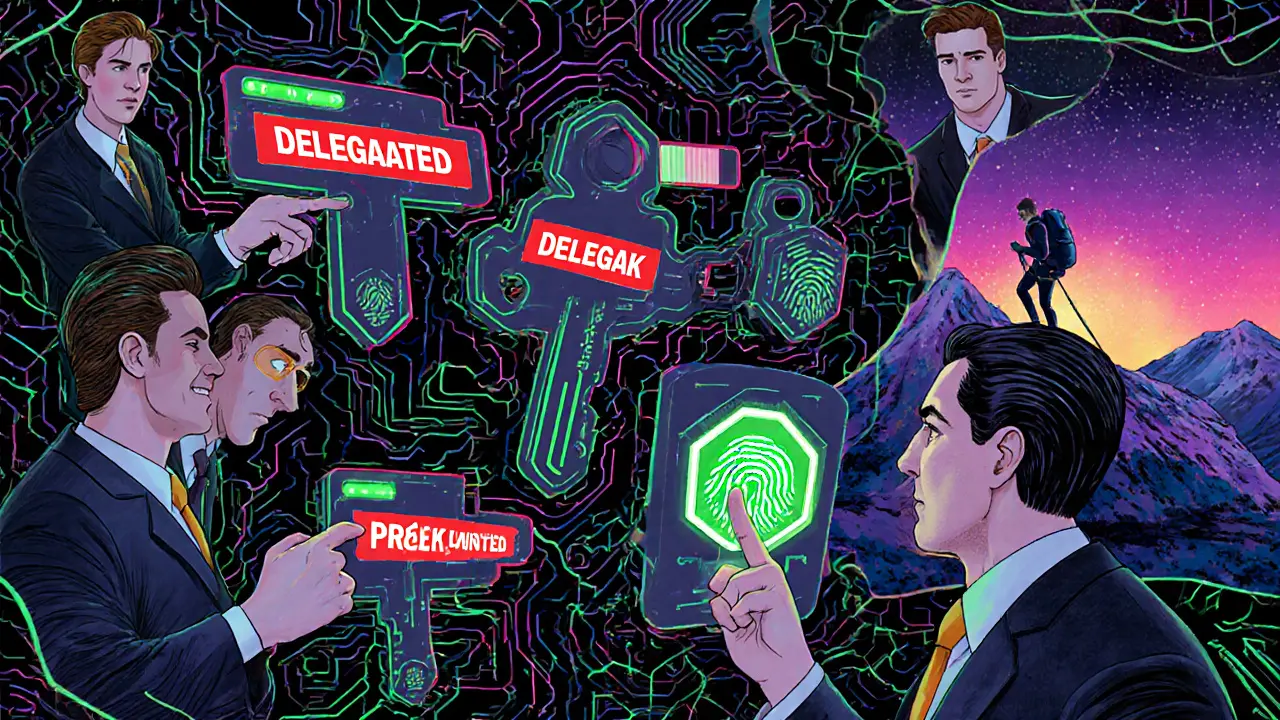MultiSig Use Cases for Businesses: How Companies Use Multi-Signature Wallets to Secure Crypto
Multi-Signature Wallet Calculator
Wallet Configuration
Results
Security Level
Maximum Security
Risk Reduction
92% risk reduction compared to single-signature wallets
Approval Time
Approximately 47 minutes average for 2-of-3 configuration
Implementation Cost
$14,500 for basic 2-of-3 setup
When a company holds millions in cryptocurrency, having just one person control the keys is like leaving your safe with a single combination lock and giving the code to one employee. One mistake. One bad actor. One compromised device - and the whole stash is gone. That’s why smart businesses don’t use single-signature wallets. They use multisig.
What Is a Multi-Signature Wallet?
A multisig wallet requires more than one person to sign off before money can move. It’s set up as an "m-of-n" system - meaning you need at least "m" signatures out of "n" total keys to approve a transaction. Most businesses use 2-of-3 or 3-of-5 setups. In a 2-of-3 system, three people hold separate keys, but only two need to approve any payment. If one key is lost or stolen, the company still has control. If one person tries to steal funds, they can’t do it alone.This isn’t theoretical. BitGo has processed over $1.2 trillion in multisig-secured transactions since 2013. Ledger’s institutional division saw a 42% year-over-year increase in business multisig adoption between 2022 and 2023. And according to Gartner’s 2023 Digital Asset Management Report, 67% of businesses use multisig for crypto custody - far ahead of MPC wallets (29%) and single-sig solutions (4%).
Preventing Internal Fraud
One of the biggest reasons companies adopt multisig is to stop employees from stealing crypto. In 2022, BitGo’s incident reports documented 17 cases where multisig wallets blocked attempted fraud totaling $2.3 million. One user on Reddit, u/BlockchainCFO99, shared how their 3-of-5 setup stopped an employee trying to move $487,000 to a personal wallet. The other two approvers noticed the unusual pattern and flagged it immediately.Single-signature wallets are vulnerable because one person has total control. Multisig forces collaboration. Even if someone gets access to one key - through phishing, malware, or insider betrayal - they still can’t move funds without others. Vault12’s 2022 security tests showed that 3-of-5 multisig setups were 22% more effective at blocking unauthorized transactions than 2-of-3 systems. The trade-off? Higher complexity. Training time and support tickets rose by 41%.
Automating Payment Approvals
Traditional businesses still use email chains or paper forms to approve payments. That’s slow. And messy. Multisig replaces that with blockchain-verified signatures.One company using Ledger’s multisig system cut payment processing time from 3.7 days down to just 8.2 hours. How? Instead of waiting for a CFO to reply to an email, the system automatically sends a push notification to three pre-approved signers. Two of them tap "approve" on their phone, and the transaction goes through - recorded permanently on the blockchain.
This works for payroll, vendor payments, or even crypto rewards. No more chasing signatures. No more lost invoices. And because every approval is on-chain, auditors can see exactly who approved what, when, and why. That’s a huge win for compliance.

Escrow for Business Deals
Buying or selling crypto-based assets? Using multisig for escrow is becoming standard. Here’s how it works: Buyer, seller, and a neutral third party (like a lawyer or trusted mediator) each hold one key in a 2-of-3 setup.The buyer sends funds to the multisig wallet. The seller delivers the asset - whether it’s a digital product, NFT, or service. Once the buyer confirms receipt, they and the seller sign off. The third party (the arbitrator) holds the third key but only needs to step in if there’s a dispute.
BitGo’s 2023 market analysis found that 38% of business-to-business crypto transactions now use this model. It removes trust from the equation. You don’t need to believe the other party - the code enforces the deal.
Executive Oversight for Large Transactions
Big companies like Coinbase require 3-of-5 executive signatures for any transaction over $500,000. That’s not just security - it’s governance. No single executive can move large sums without approval from others.This structure prevents rash decisions, reduces pressure on individuals, and creates accountability. If a $1 million transfer happens at 2 a.m., five people know about it. And if one of those executives is compromised, the attacker still can’t act alone.
Companies that implement this level of oversight see fewer errors and more transparency. According to BitPay’s 2022 case studies, businesses that included finance, IT security, and executive leadership in the multisig setup reduced implementation failures from 34% to just 9%.
How Multisig Compares to Other Solutions
You might hear about MPC (Multi-Party Computation) wallets. They’re newer and claim to be faster. So what’s the difference?MPC splits a single private key into encrypted fragments that are used together off-chain. No full key ever exists in one place. That sounds secure - and it is. But here’s the catch: the process is hidden. You can’t see who signed what on the blockchain. That makes audits harder. For regulated businesses, that’s a problem.
Multisig, on the other hand, is fully transparent. Every signature is recorded on-chain. Regulators can verify approvals. Auditors can trace every movement. That’s why Gartner gave multisig a 4.7/5.0 for security effectiveness - and only 3.2/5.0 for complexity. MPC scores higher on speed (34% faster approvals), but lower on auditability.
For most businesses, transparency matters more than speed. Especially when you’re holding millions.

Real-World Challenges and Fixes
Multisig isn’t perfect. The biggest complaint? Keyholders go offline.58% of negative reviews on Capterra mention delays because someone was on vacation, sick, or just didn’t respond. One company reported a 14-hour delay on a critical supplier payment - because the CFO was hiking in the mountains with no signal.
That’s why new tools are emerging. Ledger introduced hierarchical approval structures in June 2023, letting executives temporarily delegate signing rights during absences. BitGo added biometric verification in May 2023, so keys can only be used with a fingerprint or face scan - reducing the risk of stolen hardware wallets.
Another fix? Automation. Some platforms now allow scheduled approvals. If a payment is due Friday and no one signs by Thursday night, the system automatically alerts backup approvers. No more waiting.
Cost and Implementation
Setting up multisig isn’t cheap. Basic 2-of-3 setups start around $14,500. Fully integrated 4-of-7 systems with audit trails, automated alerts, and compliance logging can hit $87,200. But compare that to losing $5 million to a hack.Implementation takes 8-12 weeks. The biggest mistake? Letting IT handle it alone. The most successful rollouts involve finance, legal, security, and executives from day one. That’s because multisig isn’t just a tech tool - it’s a policy. Who gets keys? When? What’s the process if someone leaves the company? What happens if a key is lost?
Companies that treat it as a process, not just software, see 75% fewer issues after launch.
What’s Next for Multisig?
Ethereum’s EIP-3074 proposal, still in testing as of mid-2023, could change everything. It introduces account abstraction, which means multisig transactions could be triggered by smart contracts instead of manual approvals. That could cut approval times by 35-40%.Forrester predicts multisig will still hold 58% of the business crypto custody market by 2027. But they also see hybrid models coming - where MPC handles day-to-day payments and multisig locks down the big transfers.
Right now, the choice is clear: if you’re holding crypto for your business, multisig is the most proven, auditable, and battle-tested method. Over 10 years, there have been zero successful attacks on properly configured 2-of-3 or higher multisig wallets, according to Dr. David Vorick of Nebulous Inc.
It’s not glamorous. It’s not instant. But when your company’s future depends on keeping crypto safe - that’s exactly what you want.
Is multisig safer than single-signature wallets?
Yes, by a wide margin. Properly configured multisig wallets reduce the risk of single-point compromise by 92% compared to single-signature wallets, according to Nervos Network’s 2022 security whitepaper. Even if one key is stolen or compromised, attackers still need additional signatures to move funds.
What’s the most common multisig setup for businesses?
The 2-of-3 configuration is the most common, used by 62% of businesses, according to CoinsDo’s April 2023 analysis. It offers a good balance between security and usability. The 3-of-5 setup is the second most popular (27%), offering stronger protection for larger organizations or higher-value assets.
Can multisig wallets be hacked?
There have been zero documented successful attacks on properly configured 2-of-3 or higher multisig wallets in over 10 years. The risk isn’t in the technology - it’s in poor implementation. If keys aren’t stored securely, or if approval workflows aren’t followed, attackers can exploit human error - not the multisig system itself.
How long does it take to approve a transaction with multisig?
Approval times vary by setup. A 2-of-3 wallet averages 47 minutes for approval, while a 4-of-7 system can take up to 3.2 hours, based on Vault12’s 2023 survey. Delays usually happen when keyholders are unavailable - not because of technical limits.
Do I need a lawyer to set up a multisig escrow?
Not necessarily, but it helps. For high-value deals, having a neutral third party (like a lawyer or escrow service) hold one key adds legal clarity. The multisig structure itself doesn’t require a lawyer - but documenting the terms of the escrow agreement does. Many businesses use standardized smart contracts from platforms like BitGo or Ledger to automate this.
Is multisig compliant with financial regulations?
Yes. The SEC’s October 2022 guidance confirmed that properly documented multisig approval workflows satisfy SOX internal control requirements for cryptocurrency holdings. However, multinational companies face challenges because the Financial Action Task Force (FATF) notes inconsistent multisig standards across countries, which can complicate global compliance.
Nabil ben Salah Nasri
November 2, 2025 AT 13:45alvin Bachtiar
November 2, 2025 AT 15:36Josh Serum
November 3, 2025 AT 20:57DeeDee Kallam
November 4, 2025 AT 09:45bob marley
November 4, 2025 AT 11:38Jeremy Jaramillo
November 4, 2025 AT 22:03Sammy Krigs
November 5, 2025 AT 03:42naveen kumar
November 5, 2025 AT 22:46Phyllis Nordquist
November 7, 2025 AT 13:26Beth Devine
November 7, 2025 AT 20:11Brian McElfresh
November 7, 2025 AT 22:49Hanna Kruizinga
November 8, 2025 AT 20:08David James
November 9, 2025 AT 16:14